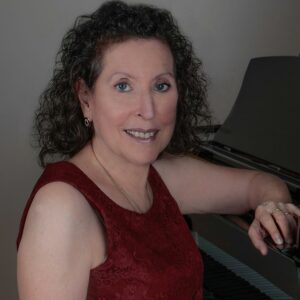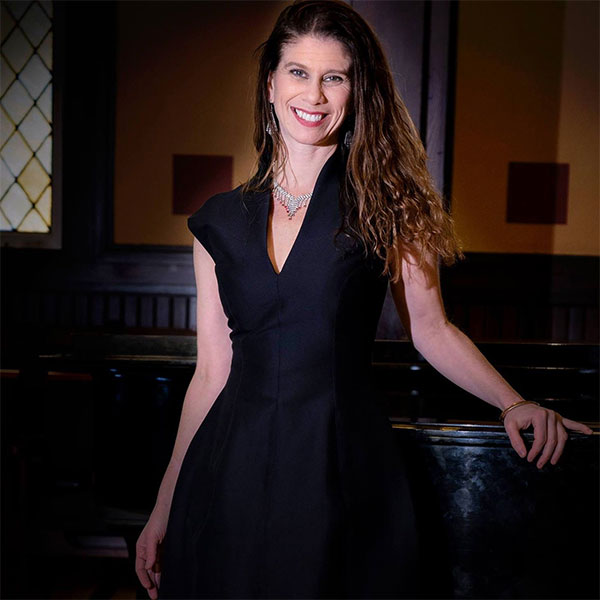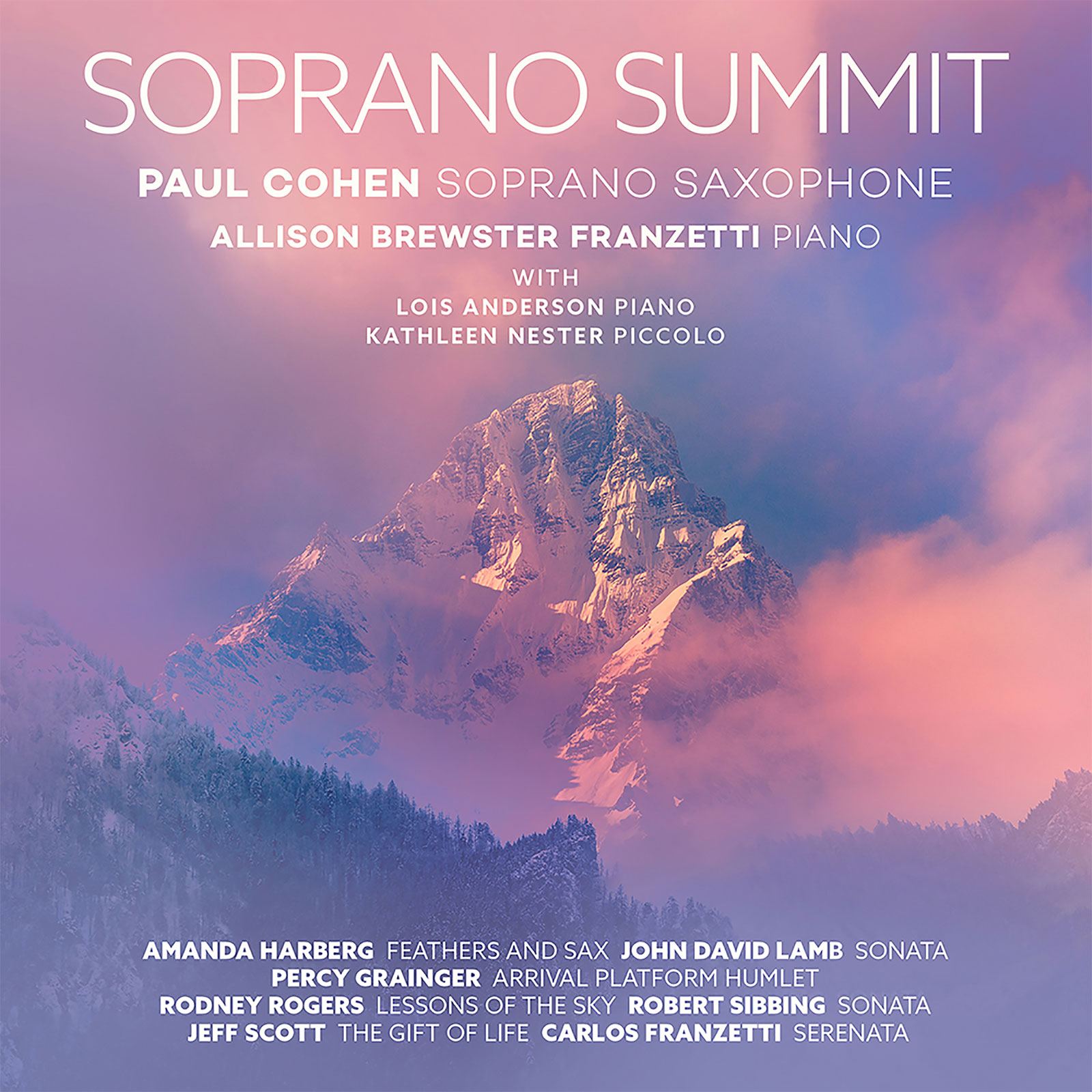Soprano Summit
Paul Cohen soprano saxophone
Allison Brewster Franzetti piano
Lois Anderson piano
Kathleen Nester piccolo
Amanda Harberg composer
John David Lamb composer
Percy Grainger composer
Rodney Rogers composer
Robert Sibbing composer
Jeff Scott composer
Carlos Franzetti composer
Ravello Records presents SOPRANO SUMMIT from revered saxophonist Paul Cohen. Alongside his work as a performer, Cohen is known for his passionate scholarship, rediscovering long-forgotten saxophone works as well as arranging related music for the instrument. In this, his latest contribution, Cohen presents an album of music for the soprano saxophone in chamber and solo settings. The range and diversity of the soprano saxophone is stunning, from Cohen’s arrangement of Percy Grainger’s Arrival Platform Humlet (solo soprano saxophone) to Amanda Harberg’s first piece for saxophone, Feathers and Sax, (soprano saxophone and piano) and Jeff Scott’s new work The Gift of Life (piccolo, soprano/alto saxophone and piano). SOPRANO SUMMIT is both a celebration of the soprano saxophone as a concert instrument and a revelation of new, lost, revived, and beloved works.
Listen
Stream/Buy
Choose your platform
"Those who are looking for some very accessible and engaging works for saxophone will find a great deal to revel in here."
Track Listing & Credits
| # | Title | Composer | Performer | |
|---|---|---|---|---|
| 01 | Feathers and Sax | Amanda Harberg | Paul Cohen, soprano saxophone; Allison Brewster Franzetti, piano | 6:40 |
| 02 | Sonata: andante - animato - andante | John David Lamb | Paul Cohen, soprano saxophone; Lois Anderson, piano | 5:29 |
| 03 | Sonata: adagietto | John David Lamb | Paul Cohen, soprano saxophone; Lois Anderson, piano | 5:33 |
| 04 | Sonata: scherzo | John David Lamb | Paul Cohen, soprano saxophone; Lois Anderson, piano | 5:01 |
| 05 | Arrival Platform Humlet | Percy Grainger arr. Paul Cohen | Paul Cohen, soprano saxophone | 2:54 |
| 06 | Lessons of the Sky | Rodney Rogers | Paul Cohen, soprano saxophone; Allison Brewster Franzetti, piano | 8:41 |
| 07 | Sonata: allegro moderato | Robert Sibbing | Paul Cohen, soprano saxophone; Allison Brewster Franzetti, piano | 4:59 |
| 08 | Sonata: andante | Robert Sibbing | Paul Cohen, soprano saxophone; Allison Brewster Franzetti, piano | 4:48 |
| 09 | Sonata: allegro scherzando | Robert Sibbing | Paul Cohen, soprano saxophone; Allison Brewster Franzetti, piano | 3:16 |
| 10 | The Gift of Life: Overture | Jeff Scott | Kathleen Nester, piccolo; Paul Cohen, soprano and alto saxophones; Allison Brewster Franzetti, piano | 3:02 |
| 11 | The Gift of Life: Tragedy and Ascent | Jeff Scott | Kathleen Nester, piccolo; Paul Cohen, soprano and alto saxophones; Allison Brewster Franzetti, piano | 3:24 |
| 12 | The Gift of Life: Celebration of Life | Jeff Scott | Kathleen Nester, piccolo; Paul Cohen, soprano and alto saxophones; Allison Brewster Franzetti, piano | 3:40 |
| 13 | Serenata | Carlos Franzetti | Paul Cohen, soprano saxophone; Allison Brewster Franzetti, piano | 4:36 |
TRACK 1 AND 5-13
Recorded 2020-21 at Trading 8’s Studio in Maywood NJ
Recording Engineer & Editing Chris Sulit
TRACKS 2-4
Recorded 1989 at The Town Hall in New York NY
Mastering Shaun Michaud
PUBLISHERS
Harberg — Presser
Lamb, Grainger, Sibbing, Scott — To the Fore Publishers, totheforepublishers.com
Rogers — Dorn Publications
EQUIPMENT
Soprano Saxophone
Rampone (curved 2018) Tracks 1, 5-13
Buescher (curved, 1924) Tracks 2-4
D’Addario Reserve reeds, #3.5
Caravan soprano mouthpiece
Alto Saxophone
Selmer Mark VI, D’Addario Reserve reeds #3.5
Caravan large chamber alto mouthpiece
Executive Producer Bob Lord
Executive A&R Sam Renshaw
A&R Director Brandon MacNeil
VP of Production Jan Košulič
Audio Director Lucas Paquette
VP, Design & Marketing Brett Picknell
Art Director Ryan Harrison
Design Edward A. Fleming
Publicity Patrick Niland, Aidan Curran
Content Manager Sara Warner
Artist Information

Paul Cohen
Paul Cohen is a sought-after saxophonist for orchestral and chamber concerts and solo recitals. He has appeared as soloist with the San Francisco Symphony, Richmond Symphony, New Jersey Symphony, Charleston Symphony, and the Philharmonia Virtuosi. His many solo orchestra performances include works by Debussy, Creston, Ibert, Glazunov, Martin, Loeffler, Husa, Dahl, Still, Villa-Lobos, Tomasi, and Cowell. He has also performed with a broad range of orchestras, including the New York Philharmonic, Metropolitan Opera (NYC), American Symphony Orchestra, Cleveland Orchestra, Santa Fe Opera, New Jersey Symphony, Oregon Symphony, San Diego Symphony, Long Island Philharmonic, Group for Contemporary Music, Greenwich Symphony, and New York Solisti.

Allison Brewster Franzetti
The 2014 and 2018 Latin Grammy® Nominee for Best Classical Album and 2008 Grammy® Nominee for Best Instrumental Soloist without Orchestra, pianist Allison Brewster Franzetti has received international acclaim from critics and audiences alike for her stunning virtuosity and musicality, both as a soloist and chamber musician. Her performances include the live Latin Grammy® Awards television broadcast, the Grammy® Awards Classical Music Tribute to Earl Wild and Lang Lang at the Walt Disney Concert Hall in Los Angeles, the American Classical Music Hall of Fame, the Robert Schumann Festival at the Marcella Sembrich Museum in Lake George NY, the Campeche Festival in Mexico, and at the opening of the VI International Festival of Music at the Teatro Colon in Buenos Aires, Argentina.

Amanda Harberg
Amanda Harberg is a dynamic, expressive composer and pianist whose work communicates on emotional, spiritual, and intellectual levels. Harberg weaves her deep admiration for the classical tradition together with contemporary influences to create a distinctively personal style. Her music has been presented at Carnegie Hall, Lincoln Center, Verizon Hall, the Philadelphia Chamber Music Society, and Bargemusic, and has been described by The New York Times as “a sultry excursion into lyricism.”

John David Lamb
John David Lamb was born in Portland OR in 1935 and raised in Yakima WA. He received a bachelor’s degree from San Francisco State in 1956 and a master’s in composition and conducting in 1958 from the University of Washington. In addition to a Ford Foundation/MENC composer‑in‑residence grant, Lamb has several times traveled to Sweden for intensive studies in ethnic Swedish music.

Percy Grainger
Percy Grainger’s relationship with the saxophone was both joyous and far-reaching. He included the saxophone — sometimes singly, other times within a complete family — in many of his orchestral, chamber, band and solo works. Grainger was convinced of the ideal musical qualities of the saxophone from his very first encounter with the instrument.

Rodney Rogers
Rodney Rogers is one of a new generation of composers who draws on past musical traditions to create a unique and expressive compositional style. Cast in a late 20th century “Modern Impressionism,” Rogers combines traditional classical forms with elements of New Age, Minimalism, Jazz, and Folk music, creating an impressionistic work flowing with images. In Lessons of the Sky, atmospheric moods and sustained textures are contrasted with provocative rhythms and haunting lyricism, all cast into one multi-sectioned work.
Robert Sibbing
Robert Sibbing (1929 – 2017), was a saxophonist and composer from Illinois who taught for many years at Western Illinois University in Macomb IL. In addition to teaching saxophone, he directed the Jazz Ensemble and was active as a composer and conductor. His other works for saxophone include Moments (alto saxophone, bassoon, tuba or bass), Pastiche (alto saxophone and horn), Prairie Flower Portraits (alto saxophone and viola or violin), Four Places on the Prairie (alto saxophone and bassoon), Pastiche #2 (clarinet, alto saxophone, bassoon, percussion) and Three Pieces (alto saxophone and organ).

Jeff Scott
A native of Queens NY, Jeff Scott started the French horn at age 14. He received degrees from the Manhattan School of Music and SUNY at Stony Brook. Scott has enjoyed a performance career as an orchestral, chamber, and studio musician, performing with Ballet and Opera companies, Broadway shows, as well as touring and recording with various artists for film, classical music, pop music, and jazz.

Carlos Franzetti
A native of Queens NY, Jeff Scott started the French hoFrom symphonies to big band jazz, chamber works to Latin American music and film scores – Carlos Franzetti has no limits. Winner of a Grammy Award in 2015, he has also won five Latin Grammy Awards for Best Tango Album, Best Classical Composition, and Best Instrumental Album. Carlos Franzetti has been the recipient of grants and awards, including the New Jersey Council on the Arts Composers’ Fellowship, The Yamaha Composers Award, The Trofeu Laus from Spain, a Clio Award, The Prensario Award, Premio Konex from Argentina, The Foundation for New American Music, several grants from Meet the Composer, and two gold records.

Kathleen Nester
Kathleen Nester is Solo Piccolo/Assistant Principal Flute of the New Jersey Symphony Orchestra and also plays flute in the Stamford Symphony Orchestra in Connecticut. Nester is a highly sought-after freelance artist in the NYC metropolitan area and has performed with the New York Philharmonic, New York City Opera, Orchestra of St. Luke’s, Mostly Mozart, Lincoln Center, Caramoor, and Bravo! Vail Music Festivals.

Lois Anderson
Pianist Lois Anderson has performed at Lincoln Center and Carnegie Hall, played orchestral keyboards with Orchestra New England and New Jersey Symphony, and worked with singers of the National Chorale and Lake George Opera Festival in concerts and tours. She has performed with the Finger Lakes Chamber Music Festival, Manhattan Contemporary Chamber Ensemble, and premiers involving piano with Gamelan Son of Lion.

